NCERT Solutions for Class 4 EVS Chapter 9 - Different Lands, Different Lives
Page No. 131
Activity 1
Q: You might have visited some places during your vacation. Write the name of the places and something special about them. Ask two or three of your friends about the places they had visited, and fill the table given below. 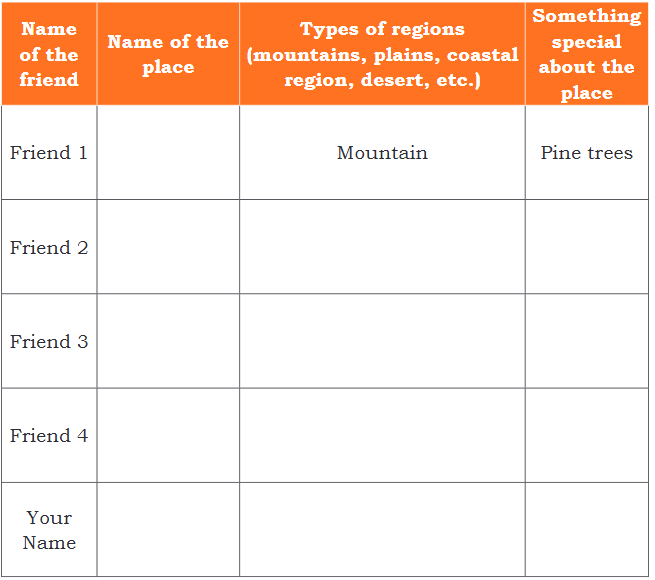
- Which type of place do you find interesting?
- What similarities and differences do you find in the place you visited, and those visited by your friends?
Ans: 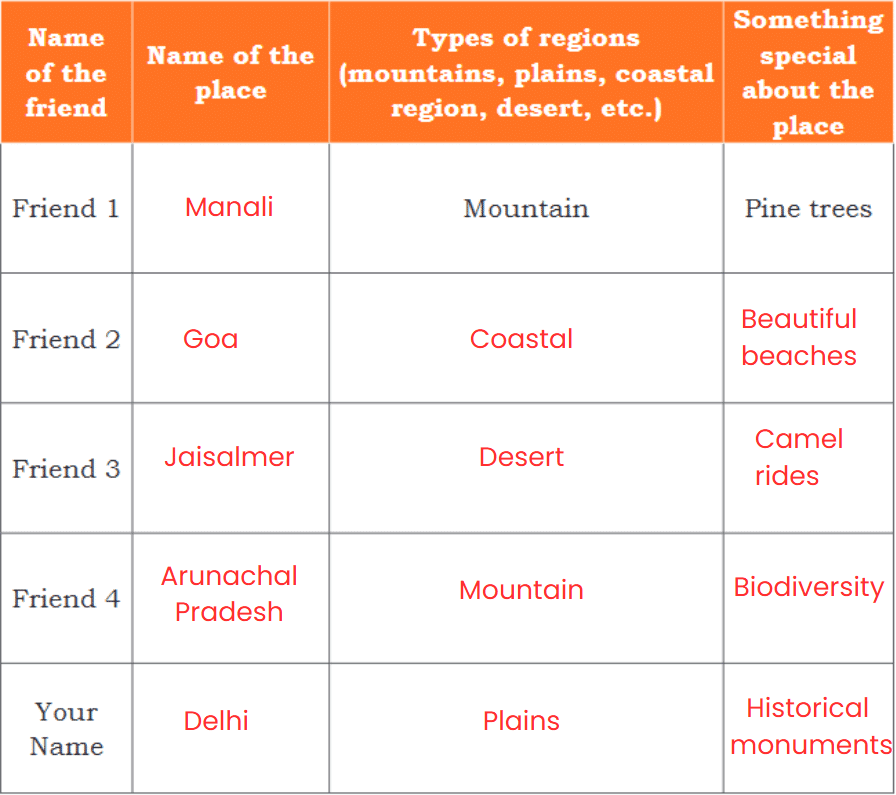
- I find coastal places interesting because I love playing on the beach and collecting seashells.
- Similarities and differences:
Similarities: All places have unique food and fun activities. For example, Manali has thukpa, and Goa has fish curry.Differences: The weather is cold in mountains like Manali but hot in deserts like Jaisalmer. Coastal areas have beaches, while plains have fields.
Page No. 132
Write
 Look at the picture above and write your observations:
Look at the picture above and write your observations: Q1: What kind of land do you see in the picture?
Ans: Land type: Rural or semi-urban setting with open spaces, dirt roads, trees, and simple structures.
Q2: List the activities that people are engaged in.
Ans: Activities:
- One women making pony tail of a girl.
- One Women is churning ( Traditional method of making butter).
- One man sitting on charpai or khat or manji ( traditional woven bed ) and drinking from glass probably lassi.
- Cow is eating chara ( grass).
- A man is bringing bundle of green fodder.
- One man is riding bicycle.
- One milkman is passing by riding on his bike , carrying three buckets of milk.
- One man is passing by riding tractor and carrying many people in trolley of tractor.
- One man is compling and carrying green fodder.
Q3: Which animals do you see in the picture?
Ans: Cow
4. Do you notice anything unique about the clothing of the people?
Ans: Traditional attire, including sarees, salwar kameez, lungis, and turbans, reflecting cultural significance.
Page No. 133
Write
Q1: What is the most popular food in your region? Can you list the main ingredients used in its preparation?
Name of the food item: ____________________________________________
Ingredients: ___________________________________________________________
Ans:
Name of the food item: Sarson ka Sang, Makki di Roti with ghee along with big glass of lassi.
Ingredients:
- Makki di Roti made from : Corn flour
- Sarson ka Sang made from : Mustard leaves
- Ghee and Lassi : Both are Milk products
You can write about a dish popular in your area, like idli, dosa, or biryani, and list its ingredients.
Page No. 134 - 135
In the Land of Endless Sand, with Ritika
Look at the following picture and write your observations.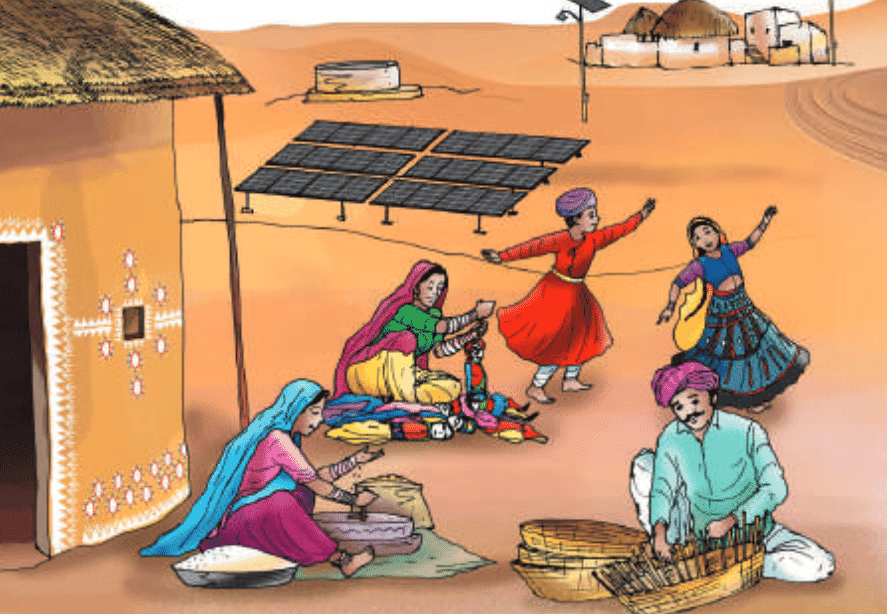
Ans:
- One women is grinding grains into flour with chakki.
- A man and a woman are dancing.
- One woman is making puppets.
- One man is making baskets.
- Solar Panels are being installed.
- The land is completely covered by sand.
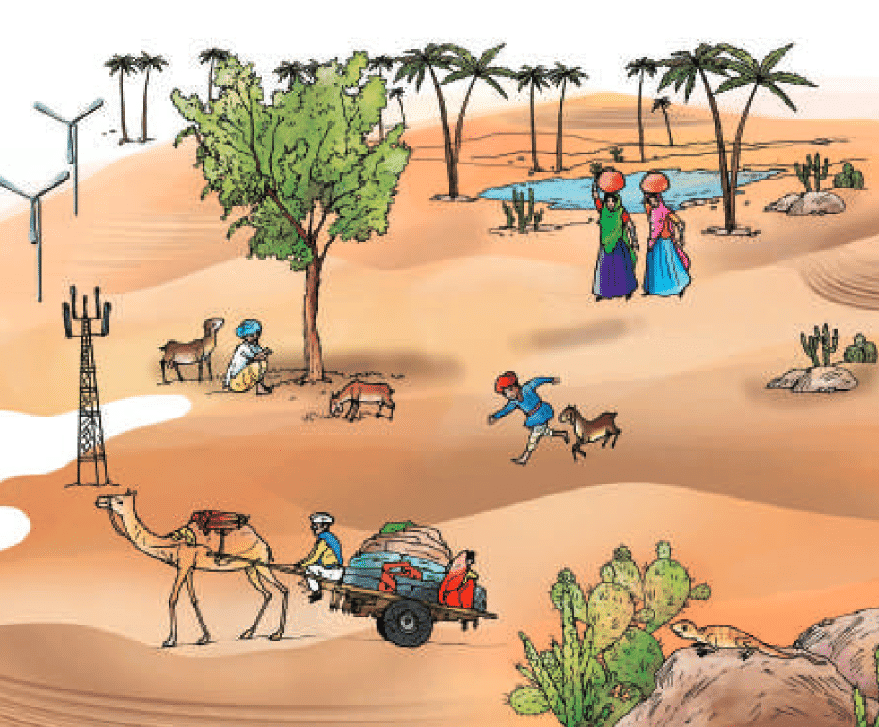 Q1: What kind of land do you see?
Q1: What kind of land do you see?
Ans: The picture shows a desert. Deserts are places with lots of sand and very little water. You can see sandy ground everywhere, which is typical of deserts.
Q2: What types of plants do you see in the picture? How are they different from the plants you see in your locality?
Ans: In the picture, there are cacti (spiky plants) and palm trees. These plants are special because they can survive in very dry places where there isn’t much water.
In your area, you might see green grass, big trees, and flowers that need lots of water to grow. Desert plants are different because they don’t need as much water and can live in hot, dry places.
Q3: Is there something unique about the way people in this village are dressed?
Ans: Yes, the people in the picture are wearing long clothes and head coverings. This helps protect them from the hot sun and blowing sand. Their clothes are colourful, which is nice to look at and might be part of their culture.
Q4: How do you think people travel in deserts?
Ans: People in the desert use camels to travel. Camels are like big animals that can carry things and walk for a long time without needing much water. They are perfect for travelling in the desert.
Sometimes, people also use trucks or other vehicles, but camels are still very important because they can go where vehicles can’t.
Q5: What do you like the most in the picture?
Ans: I like how the people are working together and doing fun activities like two women carrying and balancing pots filled with water on there head and a child playing with a goat.
Page No. 137
Find out
Q: Ask your family members about the folk songs and dances from your region, and note them down in the table below.
Ans:
 Ask your family about dances and songs from your area, like Lavani (Maharashtra) or Bihu (Assam), and fill the table.
Ask your family about dances and songs from your area, like Lavani (Maharashtra) or Bihu (Assam), and fill the table.
Page No. 138
Discuss
Q: Why do you think water is scarce in the desert?
Ans: Water is scarce in the desert because it gets very little rainfall. The hot sun makes water dry up quickly, and there are no big rivers or lakes. People store water in tankas (water tanks) to use it carefully.
Page No. 139
On the Seashore, with Chandni
Look at the picture given below and write your observations.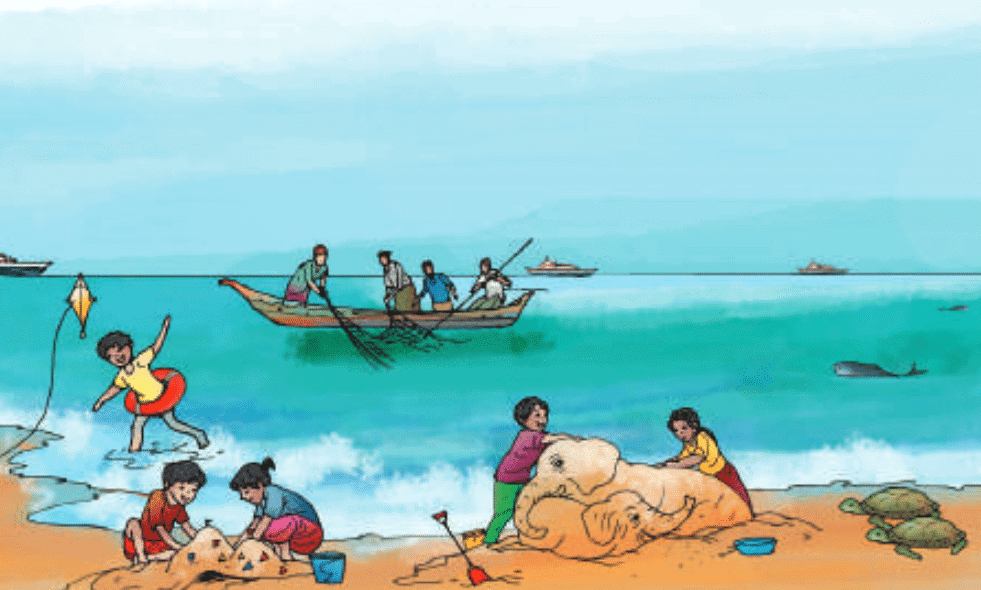
Q1: List the different kinds of activities that the people are doing.
Ans: The people in the picture are doing many fun things at the beach:
- One child is flying a colorful kite near the shore with a life-tube on his waist.
- Two groups in a pair of two are making sandcastles using buckets and shovels.
- A group of people in a boat is fishing in the sea.
- Two turtles are moving on sand near the shore.
- Three boats are saiing far away.
- One whale is there in the sea.
Q2: What kinds of trees are found near the sea, and how are they different from those in the deserts and plains?
Ans: Near the sea, you often see palm trees. These trees are tall with big leaves and can grow right along the shore.
Palm trees are different from desert plants like cacti because:
- Cacti are small and spiky, while palm trees are tall and have big leaves.
- Palm trees need more water than cacti but can still survive near the sea where there’s plenty of moisture.
In plains, you might see other types of trees like mango or banyan trees, which are bigger and have lots of branches. Palm trees are special because they can handle salty air near the ocean.
Q3: List the fun activities you would like to do on a beach.
Ans: If I were at the beach, I would love to do these fun activities:
- Swimming : Playing in the cool water and splashing around.
- Building sandcastles : Making towers and forts out of sand.
- Flying kites : Watching my kite soar high in the sky.
- Collecting seashells : Finding pretty shells along the shore.
- Playing with friends : Having picnics and games on the sand.
- Watching boats : Seeing fishing boats come in with their catch.
Q4: What is special about the dresses people wear in the coastal regions?
Ans: People in coastal regions often wear clothes that are lightweight and comfortable because it’s usually very hot near the sea.
They might wear:
- Shorts and t-shirts: To stay cool in the heat.
- Swimwear: Like swimsuits or shorts for swimming.
- Hats and sunglasses: To protect themselves from the sun.
The clothes are usually bright and colorful, matching the beautiful blue of the sea and sky.
Page No. 141
Activity 2
Let us Create
Use one coastal item to create a fun decor object like a photo frame, a necklace, a painted pebble, a mini basket or a sand art jar. Add your own creative twist and display your work in the class! You can use any other locally available materials to create the decor items.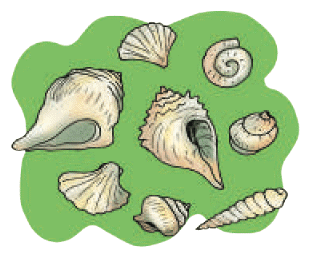 Ans: You can make a fun decor item using a coastal item. For example:
Ans: You can make a fun decor item using a coastal item. For example:
- Seashell Necklace: Collect small seashells from the beach. Make a hole in each shell and string them together with a thread. Add beads for extra colour.
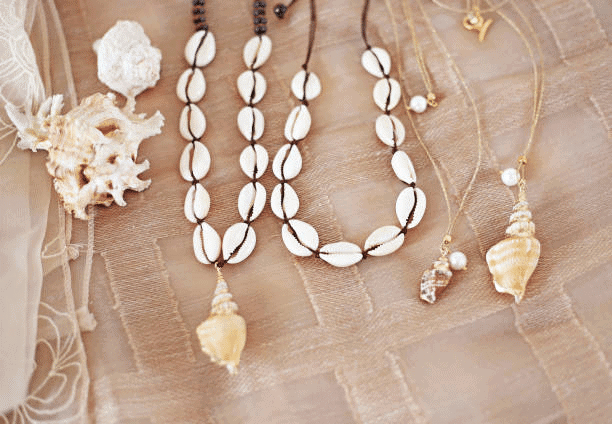
- Sand Art Jar: Take a small glass jar. Fill it with layers of coloured sand from the beach. Seal the jar and decorate it with a ribbon.
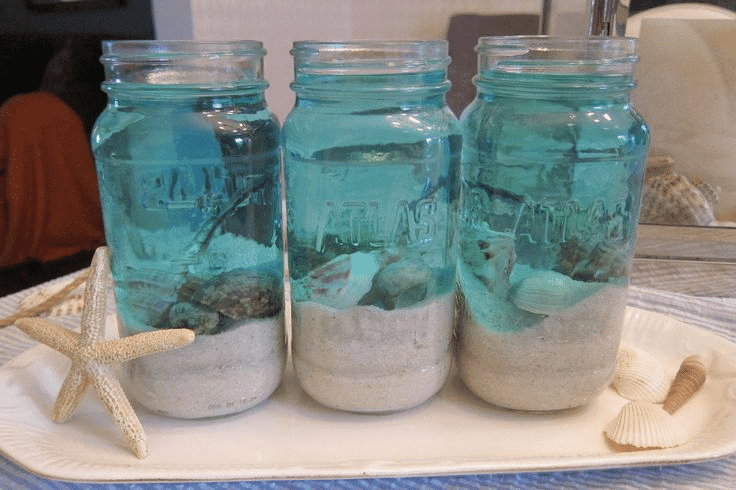
Use materials like shells, pebbles, or sand, and show your creation in class!
Page No. 142
Discuss
Q1: Write your observations on how the life around a coastal region differs from the life in a desert.
Ans: Coastal vs. Desert Life:
- Coastal Regions: People fish, make sand art, and eat seafood like fish curry. The weather is humid, and there are coconut trees.
- Deserts: People farm less, eat foods like dal-bati, and travel by camels. The weather is dry, and there are cactus plants.
Q2: Why is it important to keep our beaches clean?
Ans: Keeping beaches clean helps sea animals like turtles and dolphins stay safe. It also makes the beach beautiful for everyone to enjoy.
Activity 3
Can you identify these creatures?
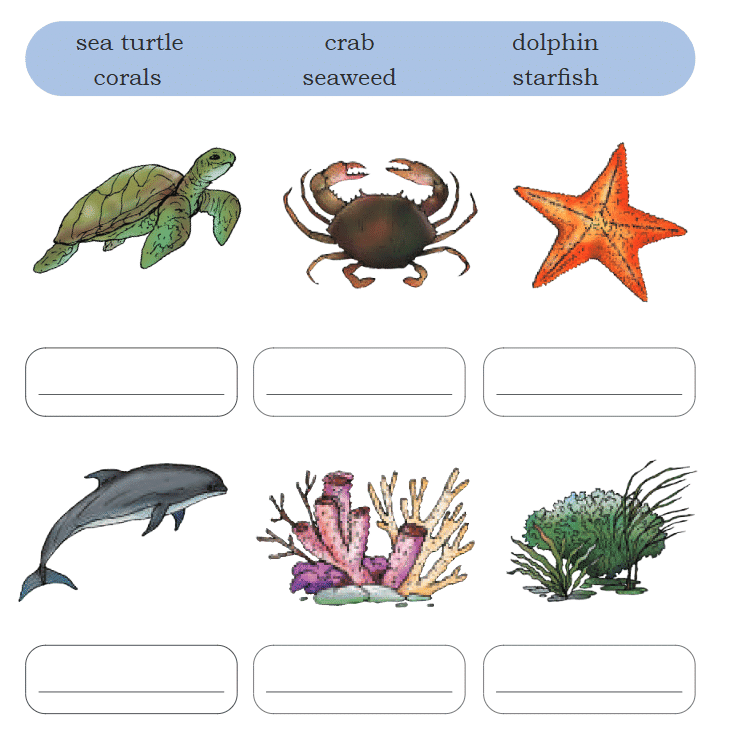 Ans:
Ans: 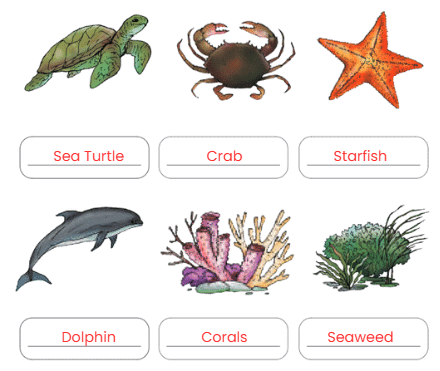
Page No. 143
Discuss
Q1: What are the adverse effects of a cyclone?
Ans: Cyclones bring strong winds and heavy rain, which can damage houses, trees, and crops. They can also harm animals and make it hard for people to get food or travel.
Q2. How can communities be better prepared for such situations?
Ans: Communities can:
- Listen to weather warnings and move to safe places.
- Store food, water, and medicines before a cyclone.
- Build strong houses that can stand against strong winds.
- Help each other by sharing resources after a cyclone.
Page No. 145
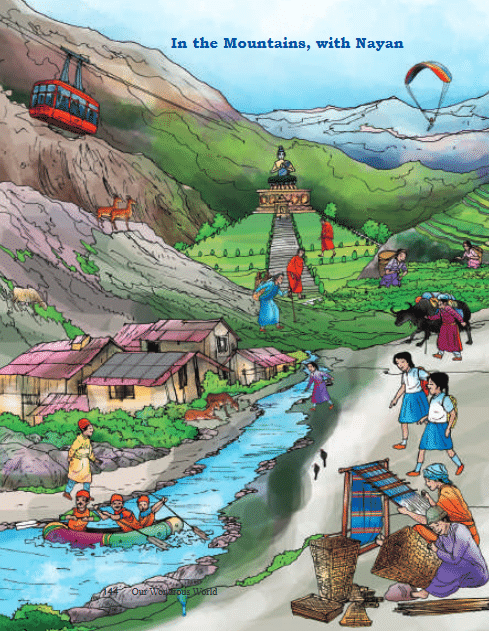
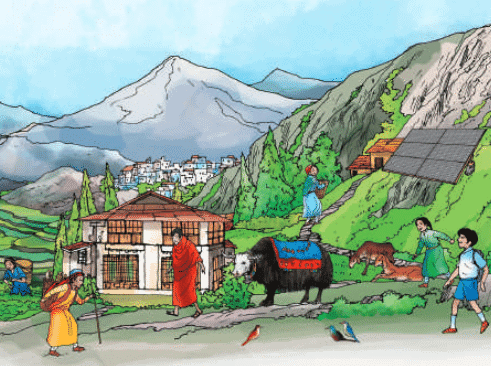
Look at the picture above and write your observations.
Q1: What type of animals do you see in the picture?
Ans: The picture shows animals like yaks, goats, and birds.
Q2: How are the dresses worn by people living in the mountains different from those worn in your region?
Ans: People in mountains wear thick clothes like bakhu or jackets to stay warm, unlike the light clothes (like t-shirts) worn in my region.
Q3: Describe the trees found in the mountains.
Ans: Mountain trees like pine and oak are tall with needle-like or broad leaves. They can grow in cold weather.
Page No. 147
Discuss
Q1: How does the cold climate in mountain regions affect the way people live and dress?
Ans: People in mountains live in wooden houses to stay warm. They wear thick clothes like jackets and shawls to protect from cold.
Q2: What traditional clothes are worn in your region? How do they match with the local climate?
Ans: In my region, people wear cotton sarees or kurta-pajama. These are light and cool for the hot climate.
Q3: Why do you think certain trees, like pine and oak, grow better in the mountains?
Ans: Pine and oak trees grow better in mountains because they can survive cold weather and rocky soil.
Q4: How do animals like yak survive in the cold climate of Sikkim?
Ans: Yaks have thick fur to keep warm. They eat grass and can walk on steep slopes, making them perfect for mountains.
Page No. 148
Discuss
Q1: Why do you think traditional houses in Sikkim are built with wood and have slanting roofs?
Ans: Houses in Sikkim are made of wood because it’s strong and keeps the house warm. Slanting roofs let snow and rain slide off easily.
Q2: Does your house have any feature that is similar to the houses in the mountains?
Ans: My house has a sloped roof to let rainwater flow away, like mountain houses.
Q3: Why are landslides common in mountains during the rainy season?
Ans: Landslides happen in the rainy season because heavy rain makes the soil loose on steep slopes, causing rocks and mud to slide.
Q4: What do you think can be done to keep people safe during the landslides?
Ans: To stay safe, people can:
- Build houses away from steep slopes.
- Plant trees to hold the soil.
- Listen to warnings and move to safe places.
Q5: What can communities do to help people who lose their homes or get affected by natural disasters?
Ans: Communities can:
- Give food, clothes, and blankets to affected people.
- Help rebuild homes.
- Work together to clean up after a landslide.
Page No. 149
Life in my Landform
Draw the landform around you in the space given below. Name the area, the type of landform, some interesting features of the people, their professions, food, houses, plants and animals. Ans:
Ans: 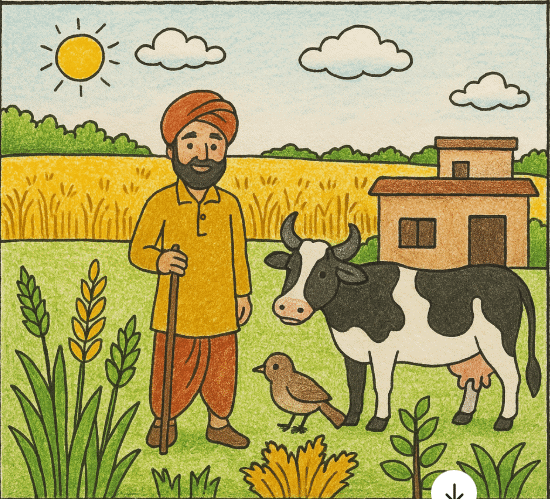
- Area: Punjab
- Type of Landform: Plains
- Interesting Features:
- People: Friendly and hardworking.
- Professions: Many are farmers or shopkeepers.
- Food: Makki di roti, sarson da saag, and lassi.
- Houses: Made of bricks with flat roofs.
- Plants: Wheat, rice, and sugarcane.
- Animals: Cows, buffaloes, and sparrows.
Write about your area and draw what you see around you!
Page No. 150 - 151
Let us reflect
Q1: Compare life in the mountains and plains by capturing the differences in trees, animals, houses, clothes, food, festivals, and art forms.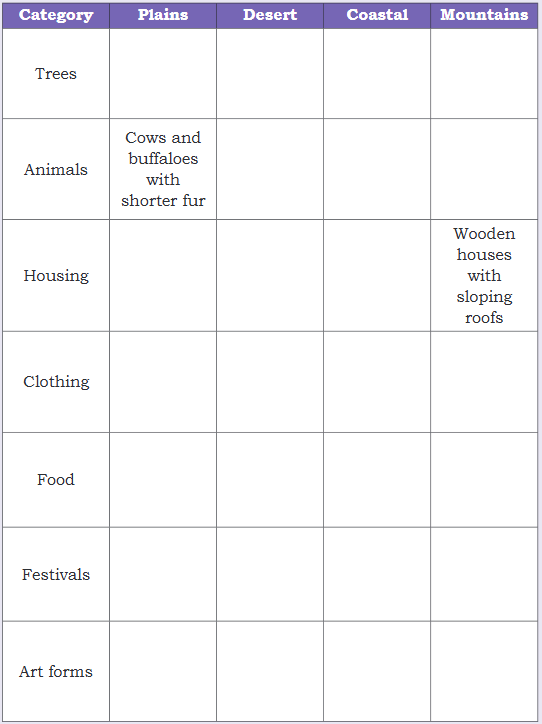
Ans: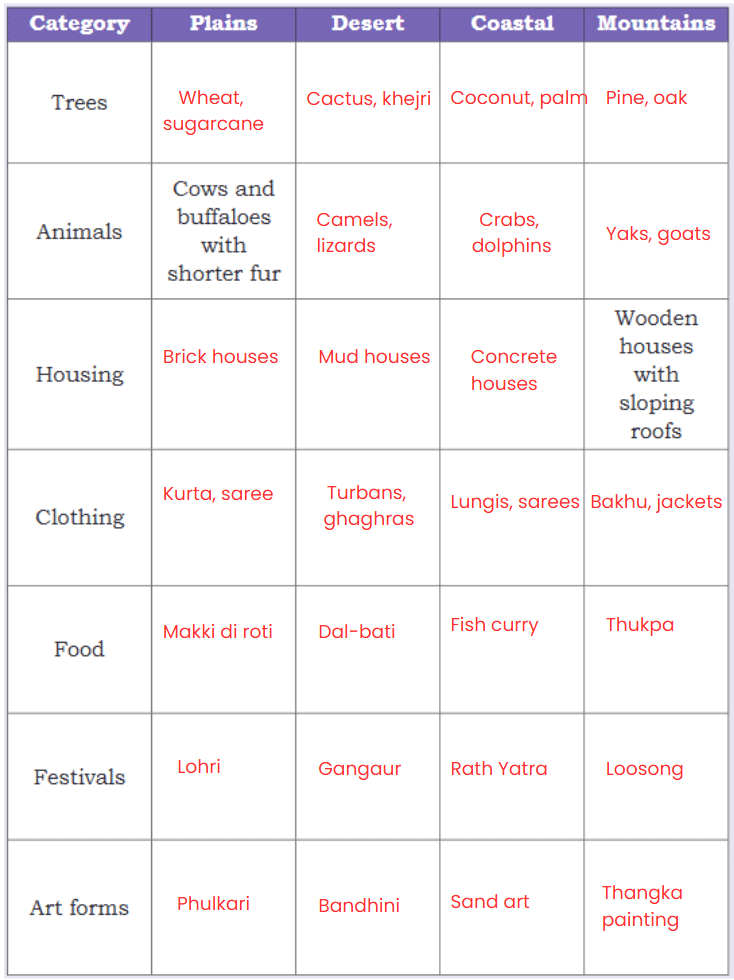
Q2: Design and draw a landform by combining your favourite features from mountains, plains, coasts, and deserts.
(a) What made you choose different features for your landform?
(b) How does each feature benefit people, animals, or plants?
(c) What difficulties might people face living in your landform?
Ans: 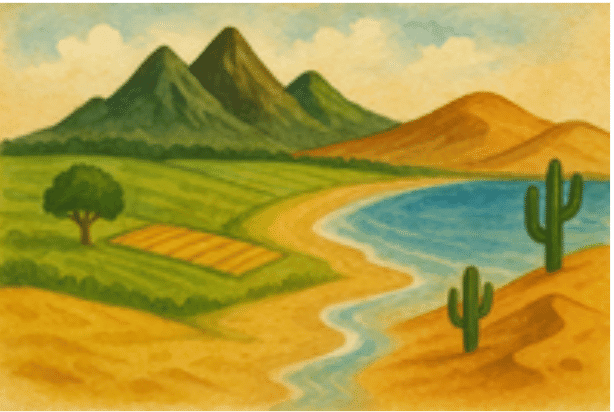
Designed Landform: A landform with mountains, a beach, fields, and a small desert.
(a) Why I chose these features:
- Mountains: They are beautiful and have cool weather.
- Beach: I love playing in the sand and swimming.
- Fields: They provide food like wheat and rice.
- Desert: Camels and cacti make it unique.
(b) Benefits of each feature:
- Mountains: Provide clean air and water for people and animals.
- Beach: Fish and shells help people earn money.
- Fields: Grow crops to feed people.
- Desert: Cacti store water for animals and plants.
(c) Difficulties:
- Mountains may have landslides.
- Beaches can face cyclones.
- Fields need a lot of water.
- Deserts have very little water.
Draw your landform with these features and explain it in class!
|
21 videos|111 docs|10 tests
|
FAQs on NCERT Solutions for Class 4 EVS Chapter 9 - Different Lands, Different Lives
| 1. What are the main themes discussed in "Different Lands, Different Lives"? |  |
| 2. How does geography influence the lives of people in different lands? |  |
| 3. Can you provide examples of different lifestyles mentioned in the article? |  |
| 4. What lessons can children learn from "Different Lands, Different Lives"? |  |
| 5. How can educators use "Different Lands, Different Lives" in the classroom? |  |





















